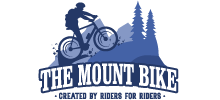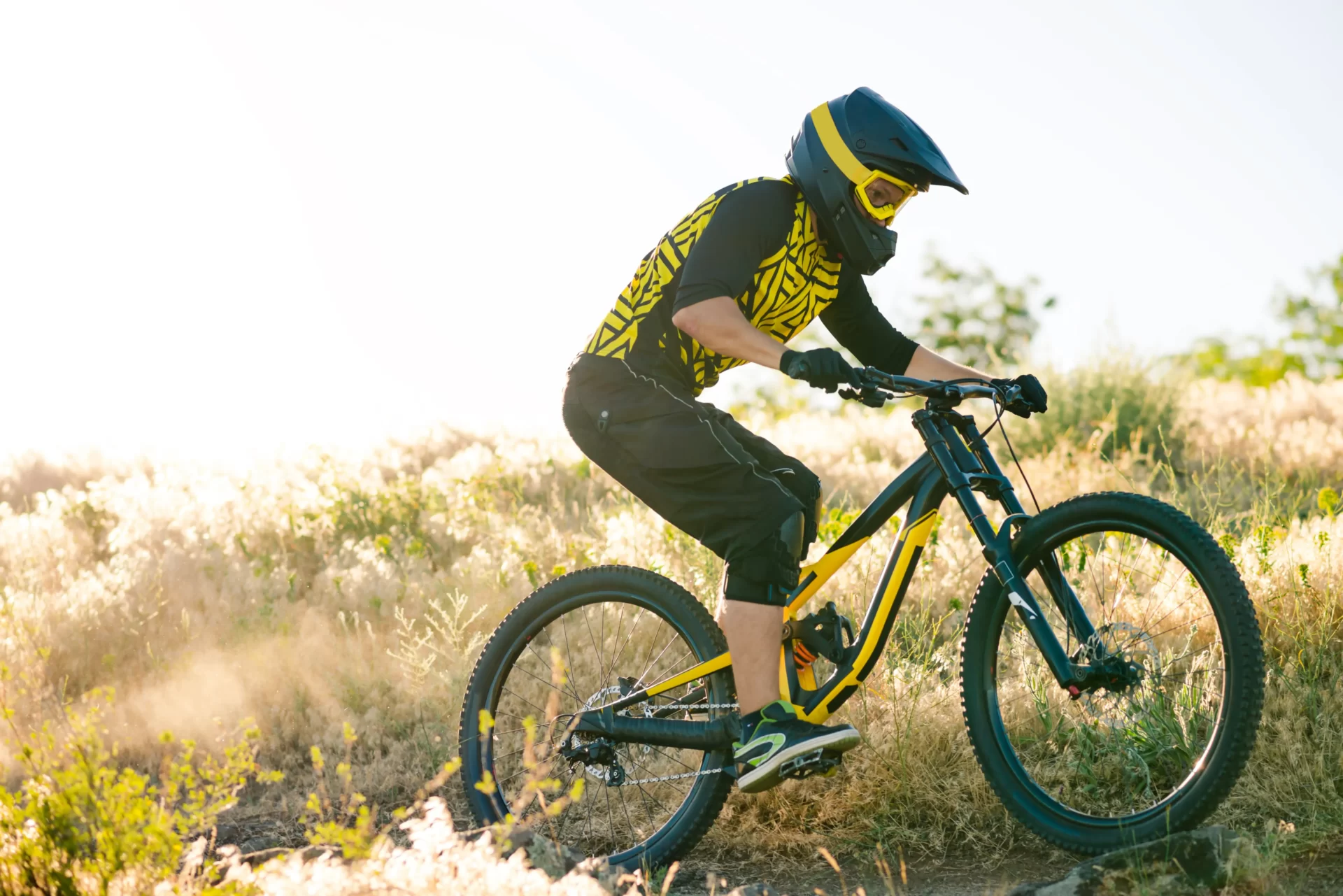Chasing after the best mountain bike can be a daunting task. There are so many bikes to choose from, and they all have different features, prices, and benefits. So, of course, it’s tough to find a perfect match.
Before buying my first bike, I also hesitated about what mountain bike should I get and which brand would live up to my requirements. The research was totally backbreaking, to be honest, and that’s why today, I’m sharing all that information so that you don’t have to go through the same road.
Hence, I’ll be going over some basic steps to help you choose your desired mountain bike. Let’s hop on the ride with me then!
Always do your research before buying an MTB so that you know exactly what features are important to you and which type of bike will suit your needs best!
What to Look for Before Purchasing an MTB?
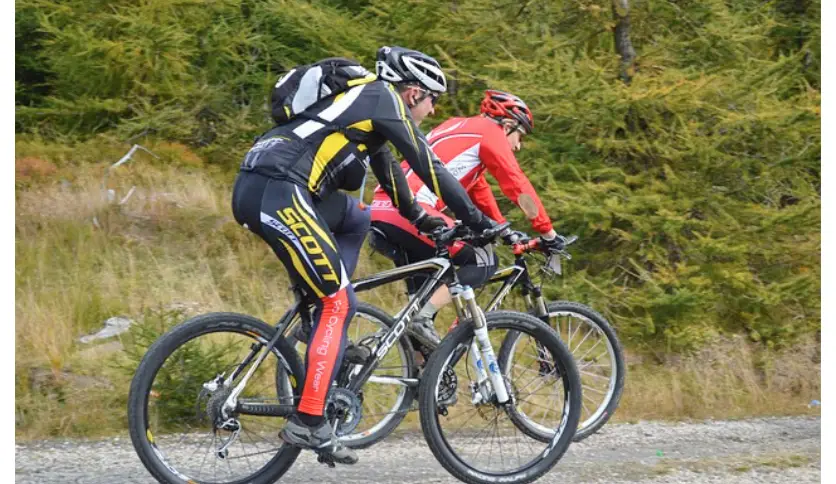
Okay, there are three things you need to consider before buying a mountain bike. They include:
- Bike Style: You must familiarize yourself with the environment or road around you. It’s because that’s where you’ll be riding the most. And the bike style differs from road to road with your preference.
- Key Features: You should focus on your priorities rather than luxury bells and whistles. Some people search for good suspension, and some look for wide wheels. So, find out what you want.
- Fit: Never buy an MTB that doesn’t go with you. Your bike should be of accurate size, design, height, color, and style, which can properly match your personality and work.
Decide Which Types Of Mountain Bike You Need
You’re not sure which type of mountain bike is the best for you.
It can be hard to figure out which type of mountain bike is the best for you. You need something that is comfortable, sturdy, versatile, as well as easy to ride.
But don’t fret, There are many types of bikes available in the market to choose from. Each type of bike has its own different capabilities. To find out the best match, let’s know which bike is best for riding over which trails.
Cross-Country
When you’re a beginner mountain biker and need a bike for rolling and uphill riding, a cross-country bike is a perfect match. Cross-country bike tires roll super fast with maximum speed, and low volume helps for long pedaling that’s needed for beginner-level riders. Additionally, this type of city bike comes with a 67-69° angle head tube, 100-120mm fork, and 120-140mm suspension shock. This xc bike mostly comes in 29 29-inch wheel sizes. But if you want you can customize a hybrid bike as per your need.
Overall, if your budget is tight and you’re in the first stage of the biking world, Cross Country Mountain Bike is a perfect choice. In addition, this full-suspension mountain bike is also a good option for riders who want to try endurance-style MTB riding.
Trail Mountain Bike
When casual riding or commuting is your preference, a trail bike is all you need. You can ride it on any type of terrain, including off-road. Trail mountain bikes usually come with a 130-150 mm fork and 130-150mm suspension shock. With a 66-65 degree head angle and dropper seat post, the trail bike is ready to cruise all types of terrain.
Whether you are an experienced rider who wants to commute or a beginner, riding a trail bike is super easy and comfortable. This type of bike is available in the market in two adult mountain bike wheel sizes, 27.5 inches, and 29 inches.
Enduro/All-Mountain
If you are an advanced-level enduro racer who wants to do regular steep riding, an enduro bike or all-mountain bike is what you need. They are perfect for riding on technical terrain, artificial or natural steep descents, and bigger climbs. In addition, this dirt jumper bike can perform exceptionally well to be back from the top in rough terrain, which is a unique thing.
This type of bike is designed with a full suspension travel of 160-180mm shock and fork, a 63-63 degree head tube, and a dropper seat post. Enduro Bikes are available in two adult sizes of 27.5 inches and 29 inches.
Downhill (DH)
Downhill mountain bike is tough and big. They’re specially designed only for downhill riding. They have the capability to jump over wooden ladders and rock gardens which is super impressive.
A downhill bike usually comes with a 200 mm fork and 200-300 mm shock rear suspension with a 63-degree headtube and fixed seat post. If you want to ride a downhill bike, you have to wear full-face helmets and body armor and take an emergency first-aid box with you. It’s because most of the crashes occur with downhill riders. It’s a risky type of bike riding.
Downhill bike is also available in two sizes enduro and cross country bike, 29 and 27.5 inches. Only advanced-level riders can handle this type of bike, it’s dangerous to ride a downhill bike without practice and proper protection.
Fat Bike
A bike with oversized tires on the front and rear wheels is called a Fat Bike. This type of bike tire size starts from 3.7 inches to 5+ inches in width. Usually, These bikes are designed for off-road use, and they offer more stability and traction than traditional bicycles.
This versatile bike is perfect for anyone who wants an adventure in exploring forests, lakes, and other remote areas. In addition, its huge tires make it easy to climb and descend steep hills. So, whether you’re a beginner or an experienced bicyclist, the fat tire mountain bike is a great choice for your next ride.
Mountain Bike Key Features That You Consider
There are countless mountain bikes, but bike suspension, frame material, brakes, gears, and wheels are the sole components that define how capable the bike is.
Hence, we’ll discuss these elements for a better understanding. Once you know about them, it’ll be easy for you to choose a suitable mountain bike.
Mountain Bike Suspension Types
To enjoy the best possible ride, you need a mountain bike with the best suspension. There are three types of mountain bike suspension available: rigid, hardtail, and full suspension. Whether you’re a beginner or a seasoned cyclist, there’s a suspension type that’s a perfect match for you. Let’s know which one is best for whom.
- Full suspension
When you want a more immersive MTB biking experience, a full-suspension mountain bike is the first choice.
Full-suspension mtb bikes are popular as they offer greater control and stability while descending or traversing steep slopes. Its front and rear fork allow riders to handle the terrain in ways that other suspensions simply can’t. In addition, it has a rear lock-out suspension that will help the power transfer super fast and efficiently to climb.
Overall, with full suspension bike climbing is much easier and absorbs all the trail chatter and bumps to provide better consistent traction even on rougher ground. Plus it reduces the rider’s impact and makes the ride easier and more fun.
- Rigid
Rigid is almost suspension-free. They’re very affordable. So, anyone who has a tight budget can get this one.
It’s easy to maintain, but most riders don’t want a rigid bike. It’s kind of a hassle to manage a rigid suspension bike and difficult to enjoy an MTB ride comfortability. Usually, fat bikes are a nice example of a rigid suspension.
- Hardtail
If you’re looking for a relatively enjoyable and comfy ride to down the hills, hardtail mountain bikes are better. In hardtail suspension, MTB bikes have a suspension fork in the front. Simplicity makes a hardtail mountain bike a solid option to choose from. hardtail bike can absorb impact and distributes minimal weight during climbs/ descents, so climbing is efficient with it. Plus, they’re very lightweight, pretty inexpensive, and easy to maintain.
These bikes are a tad bit more expensive than rigid ones but more affordable than full suspension. In addition, hardtail suspension is available in almost all types of mountain bikes, except Downhill, and overall best bike for beginners.
Mountain Bike Wheel Size
If you’re looking to conquer the trails, you’ll need the right wheel size. A standard wheel lets you feel comfortable and provides improved traction and control over your bike.
Luckily, there are a number of options to choose from. From smaller wheels to medium-sized wheels to huge and ultra-wide wheels, there’s a wheel size that’s perfect for you. In recent times, larger wheels have been available in the market, and these wheels are almost obsolete these days.
To take your mountain biking to the next level, you’ll need to make sure that your wheel size is perfect for the terrain you’re riding on.
So which wheel size is perfect for which trail?
Let’s know about the top three mountain bike wheel sizes.
- 26 inch
The 26-inch wheel was originally used for mountain bikes, and still, now, it’s sparingly used for being tight and nimble.
26-inch wheels are perfect for powering through the terrain. They are great for getting over obstacles quickly and provide better stability when riding uphill or on loose surfaces. This size provides more stability and can support heavier bikes and loads. Plus, it’s easier to maneuver in tight spaces and navigate obstacles more easily.
If you are primarily riding on dirt or soft surfaces, then 26-inch wheels may be a good option.
- 27.5 inch
This size is the most popular and preferable wheel size recently. Whether you’re new to mountain biking or just want a more comfortable ride in general, the 27.5-inch wheel size can be the perfect option! By choosing a bike with a larger wheel size, you’ll be able to traverse difficult terrain with ease and enjoy a more comfortable ride overall.
27.5-inch bikes are more playful and responsive than 26-inch wheels and sometimes even 29-inch wheels. Plus, they are also good options for other types of outdoor activities like hiking and cycling. That’s why people are loving it so much.
- 29 inch
29-inch wheels provide enough rolling resistance without being too harsh on your knees or spine. If you ride more aggressively or want to go faster, then a 29-inch wheel size may be better suited for you. They are lightweight which makes them easier to handle and less tiring overall.
Usually, professional mountain bikers use 29-inch wheels for their climbing efficiency and smoothness on difficult trails.
Mountain Bike Frame Material
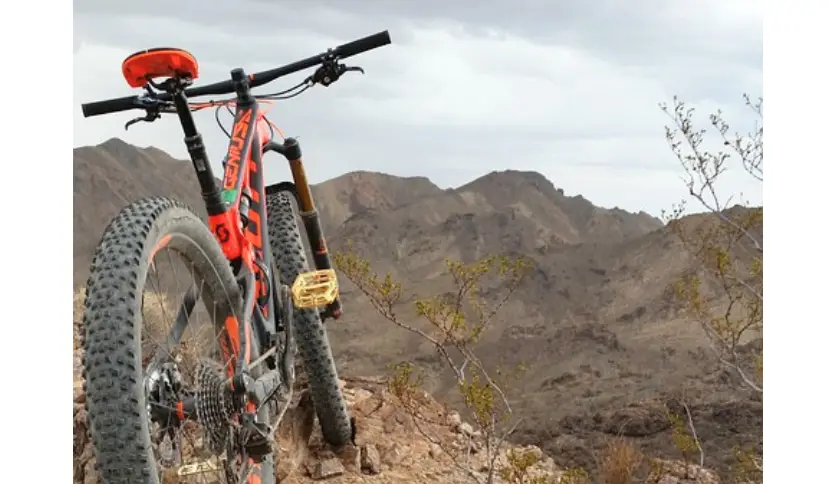
The bike’s frame influences the bike’s strength, longevity, weight, ride quality, and price. There are a variety of options, from aluminum to carbon fiber, and each comes with its own set of benefits and drawbacks. Let’s know a little bit about the best frame materials and know which one is best for which capabilities.
- Aluminum
Aluminum is the most used material in a mountain bike’s frame. It is strong, lightweight, and durable. It also has a low flexing limit which makes it resistant to shocks and vibrations. This material also conducts heat well so you will not have to worry about overheating on long rides in hot weather conditions.
Plus, aluminum also resists tarnish and corrosion due to its low reactivity. This means that your bike will look better over time as oxidation is kept at bay.
- Carbon Fiber
Carbon is a costly material, so a mountain bike made with these frames will break the bank, no doubt. Usually, athletes who engage in extreme sports like downhill racing or enduro cycling use carbon fiber-based mountain bikes, as they can withstand a lot of punishment
Its frame weight ratio and stiffness are best compared to other bike frame materials. Plus, they have excellent ventilation due to their open design, meaning that your body won’t overheat while you’re riding. This is especially important if you participate in multi-day activities like hiking or climbing.
Overall, carbon fiber may be expensive up front, but it will likely pay off in the long run by saving you money on repairs and replacements.
- Steel
While other materials, such as aluminum or carbon fiber, are lighter and more nimble, they may not be able to withstand heavy use over time. a steel frame can take more abuse without collapsing or ultimately failing. It is strong, durable, and compliant.
This type of frame is ideal for bike parks where you regularly encounter obstacles that are larger than your average city street. They are easy to repair and can be stretched or molded into different shapes without breaking down significantly. This makes it perfect for crafting custom Mountain Bikes with specific features and capabilities. Finally, welded joints in a steel frame help to ensure strength and stability even when subjected to heavy impacts and twists.
- Titanium
Titanium frames are one of the strongest frame materials for a mountain bike. They’re ideal for riders who want to ride their bike at high speeds and cope with tough terrain. Titanium is an alloy made from titanium, carbon fiber, and other materials that gives it superior strength and durability compared to traditional metal frames.
Titanium frames are rarely found in mountain bikes, as they’re too pricey but worth the price. It’s lightweight, highly durable, and doesn’t corrode even in wet environments which means it can be used outdoors year-round without worry about corrosion damage. Plus, it stands out as incredibly resilient even after a crash and still keeps going on. In addition, it requires more toil and a smart strategy to mold and give it a shape.
However, if you’re just starting out or aren’t planning on using your mountain bike for heavy off-road usage, then a standard steel frame may be a better choice.
Mountain Bike Gears
Mountain bikes give you the freedom to modify them according to your wish. That’s one of many reasons why people love mountain bikes.
Mountain biking can be quite hazardous because of debris on the trails that can injure you or cause your bike to lose balance. To avoid these situations, it is important to have sufficient mountain bike gear that will protect you from harm.
Usually, mountain bikes are available from a minimum single-speed to 30 or more gears.
Let’s keep it simple, a good starting point would be to use a lower gear when there are steep hills or long climbs involved and switch to a higher gear when you are taking shorter rides or traveling over flat ground.
Mountain Bike Brakes
Do you ever find yourself wondering what brake option is best for mountain biking? As mountain bikers, we know that we need a good brake option for when things get hairy out on the trails. Luckily, there are a few types of brakes available to choose from, and each has its own benefits and disadvantages.
Let’s run to know them.
- Disc Brakes
Disc brakes are becoming popular among riders due to their superior stopping power and durability on various surfaces. They’re made with automotive technology that makes them lightweight, low maintenance, and a reliable system to produce amazing brake control even in slippery conditions.
If you’re looking for an improved braking system that will give you greater flexibility and efficiency when driving, then a disc brake may be the best option for you!
They work by transferring the energy from the wheel to a caliper, which pushes against a brake pad. This stops the bike quickly and effectively in any terrain or condition.
- Rim Brakes
Well, you may know, that rim brakes are long gone in history. You won’t find any high-quality mountain bike with rim brakes nowadays. The modulation isn’t good, as well as the durability and reliability. It wears out very soon, stopping power is very low, can’t be controllable in muddy or wet conditions, and requires more effort to brake aggressively. Plus the weight is also not worth considering.
Only some new cheapest MTBs are made with these brakes. Simply put, you can’t trust rim brakes.
- Coaster Brake
Coaster brake systems are often seen as a better option for mountain biking for kids because they provide more control and stability. When you want to stop the bike you just need to backpedal and the rear wheel will be locked and the bike will stop immediately. Some riders also prefer it for downhill riding due to this rear-locking facility. But while going uphill, the coaster brake is less effective.
If you need a specific MTB bike just for downhill riding, coaster brakes are perfect, and some brands are doing so. Downhill bikes with a coaster brake in limited pieces are making a comeback in the MTB industry.
What is a Good Price for a Beginner Mountain Bike?
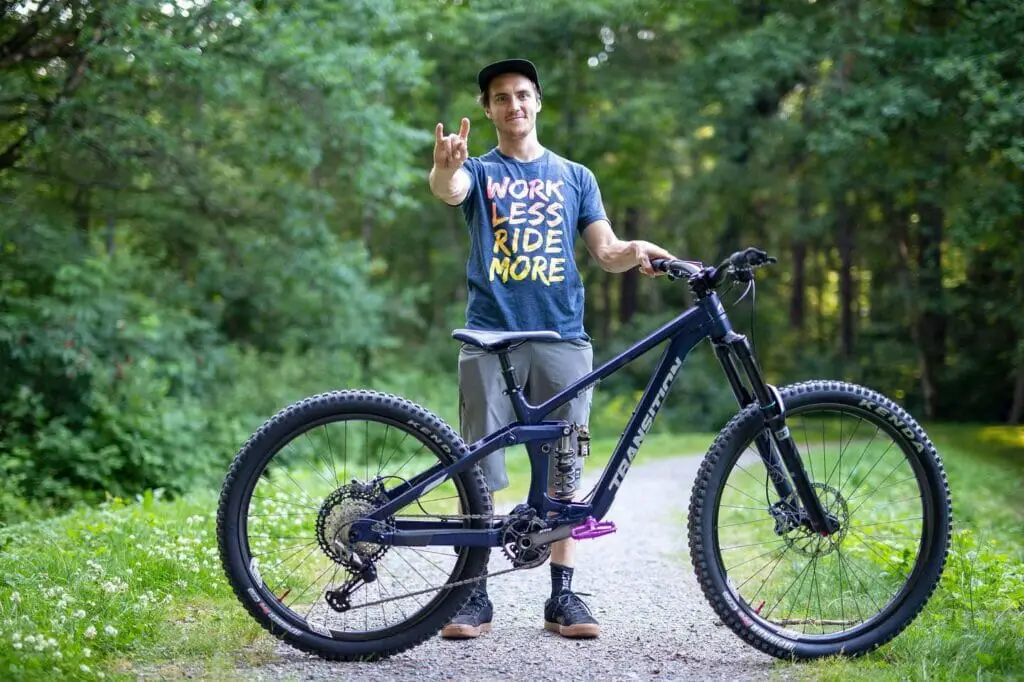
I’m pretty sure, by now, you know a whole lot about mountain bikes. But do you know there are differences in the price of these bikes? Although mountain bikes are kind of similar in their parts, the contract lies in the cost.
Mountain bikes which are around $300-$450 are actually not the real ones (mostly). The materials are kind of cheap, so the price tag is lower. But this doesn’t mean they’re useless. If you’re a beginner, you could start riding something at a low cost, to learn.
Once you master it, you can go for the premium ones. Note that these bikes are good for riding on streets and town paths, which new learners need to practice. Low-cost MTBs are clearly not for off-roading, though.
Now if you think that you can afford some medium-ranged MTB, you should go for the ones that cost around $500-$800. These bikes will be amazing for beginners and mid-level riders. They’re lightweight (which is good for new riders), and you can ride them in the hills.
Now for the expert people, I’ll recommend an MTB with better control. They have dual suspension, a good hydraulic disc brake, and aluminum plus carbon frame material are perfect for them.
Above all, it really depends on you. If you think you can afford an expensive MTB with the best control and material, you can go for it. No issues at all.
Top 6 Affordable MTB Brands for Beginners
It’s time for you to know about some really good brands that are affordable. Below I’ve added my preferences, and you’ll find them outstanding, too.
- Dynacraft
I’m sure you have already heard about Dynacraft. This brand is super famous out there, especially among the young generation. Call it design, wide wheels, dual suspension, etc.; every single piece makes these bikes worth it in every situation.
The high quality and heavy-duty parts have made this brand popular for straight fifty years. They’re like the leading players in the whole wheel industry.
- Schwinn High Timber
Next up, it’s Schwinn, an American brand for bikes. They’ve been in the MTB, E-bike, or any wheeler market for over 125 years. They believe in having fun and freedom while their customers are riding their bikes.
It was invented by Ignaz Schwinn, who was born in 1860, and the brand launched in 1895. And the rest is history!
- Mongoose
Mongoose brand is well known for the alloy wheel that’s made with cast magnesium. The frames of the two-wheelers are superior, and the designs are top-notch.
Besides, this one is perfect for beginner-level riders with a budget-friendly cost. They sell some really high-end bikes too!
Will you buy these brand’s bike though? Well, you can try at least!
- Roadmaster
If you’re someone who loves mountain biking, Roadmaster is for you. This brand offers some really competitive products that contain high-defined features.
Canada’s Dorel industry (a subsidiary), Pacific Cycle, owns Roadmaster, which has been available since World War 2. For this, the design of the bikes is vintage as well.
- Huffy
Well, Huffy, a Chinese-owned company, provides bikes for not only Men but also for Women and Kids. The Mountain bikes come in different styles, sizes, and prices.
If you’re a beginner or mid-level biker, you can try the MTBs of this brand, all their creations are splendid. I’m sure you’ll have a good riding experience with them.
- Hiland
Last but not least, for the last 20 years, Hiland has been one of the best mountain bike brands without any doubt. They’re popular in the market because of their trendy look, excellent performance and very affordable price.
Plus, the bikes are super easy to control in any type of terrain.
Conclusion
That’s the end of our conversation for today. This is where we part ways. But, are you still feeling numbed regarding, “What mountain bike should I get?” Don’t be.
Here are some pointers you can note. First of all, make your checklist, the list of mountain bike fantasy. Ask yourself what you want in an MTB. Write them down point by point. Then, think about the wheels, frames, and brakes; like how you want them, what support you need, and where you want to travel.
Factor in all the considerations, and you’ll have your answer. Good luck.

I am Ryan Ford, a mountain biking enthusiast who loves to explore the outdoors. I also like to go on adventures with friends and anything else that involves being outside. I love my bike because it gets me out of the house and gives me an opportunity to enjoy nature.
